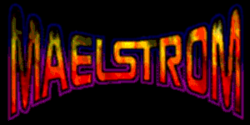| Maelstrom | |
|---|---|
 | |
| Developer | Ambrosia Software |
| Publisher | Ambrosia Software |
| Programmer | Andrew Welch |
| Platforms | Mac OS, Linux |
| Release | 1992 |
| Genre | Multidirectional shooter |
| Mode | Single-player |
Maelstrom is a multidirectional shooter developed by Andrew Welch and released as shareware in November 1992 for Mac OS. [1] The game is an enhanced clone of Atari, Inc.'s 1979 Asteroids arcade video game with a visual style similar to the Atari Games 1987 sequel, Blasteroids . [2] Maelstrom was released when there were few action games for the high-resolution color displays of the Macintosh, and the game attracted attention despite the dated concept. The response led Welch to start Ambrosia Software.
Contents
The game was later released as free and open-source software, resulting in ports for other platforms.
